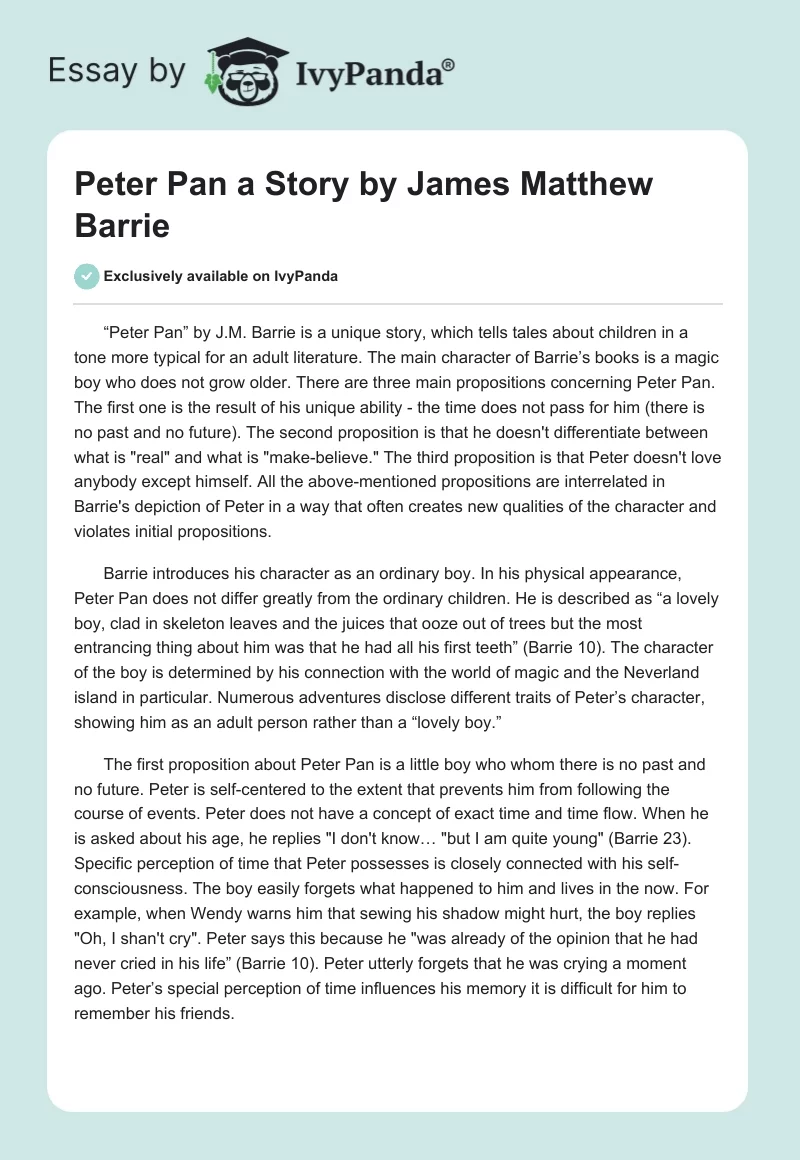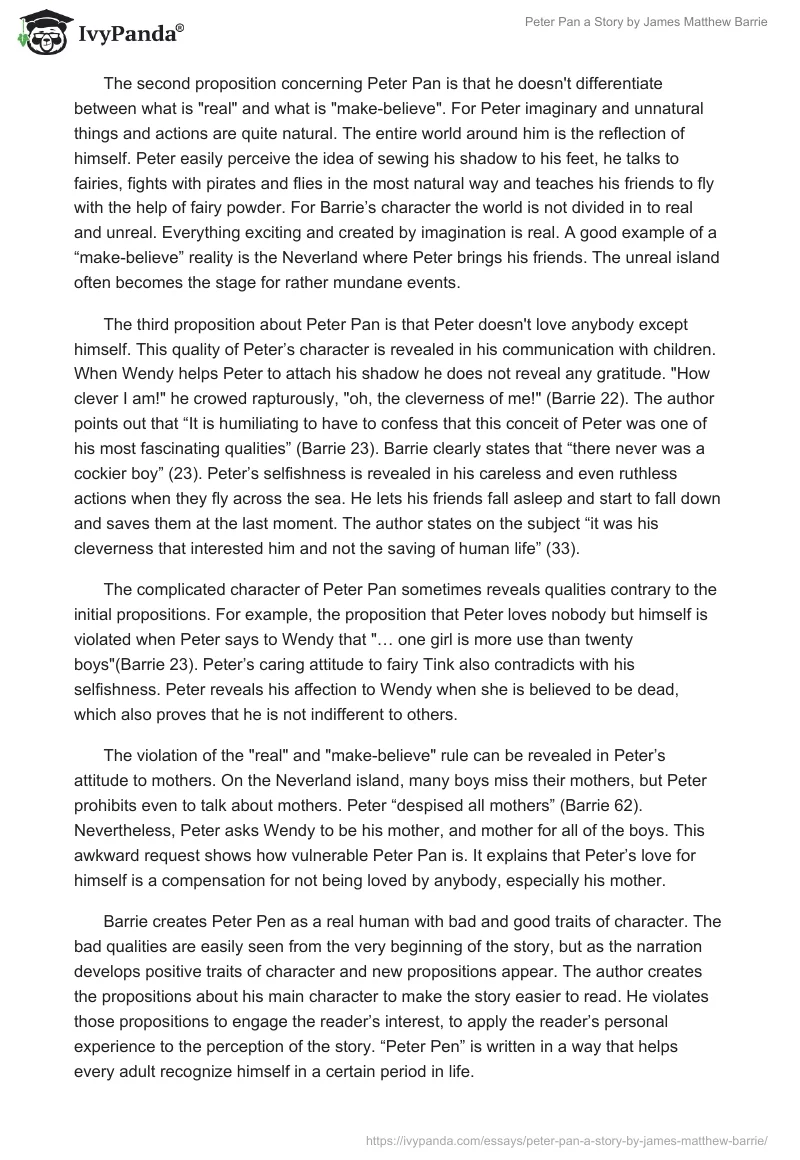“Peter Pan” by J.M. Barrie is a unique story, which tells tales about children in a tone more typical for an adult literature. The main character of Barrie’s books is a magic boy who does not grow older. There are three main propositions concerning Peter Pan. The first one is the result of his unique ability – the time does not pass for him (there is no past and no future). The second proposition is that he doesn’t differentiate between what is “real” and what is “make-believe.” The third proposition is that Peter doesn’t love anybody except himself. All the above-mentioned propositions are interrelated in Barrie’s depiction of Peter in a way that often creates new qualities of the character and violates initial propositions.
Barrie introduces his character as an ordinary boy. In his physical appearance, Peter Pan does not differ greatly from the ordinary children. He is described as “a lovely boy, clad in skeleton leaves and the juices that ooze out of trees but the most entrancing thing about him was that he had all his first teeth” (Barrie 10). The character of the boy is determined by his connection with the world of magic and the Neverland island in particular. Numerous adventures disclose different traits of Peter’s character, showing him as an adult person rather than a “lovely boy.”
The first proposition about Peter Pan is a little boy who whom there is no past and no future. Peter is self-centered to the extent that prevents him from following the course of events. Peter does not have a concept of exact time and time flow. When he is asked about his age, he replies “I don’t know… “but I am quite young” (Barrie 23). Specific perception of time that Peter possesses is closely connected with his self-consciousness. The boy easily forgets what happened to him and lives in the now. For example, when Wendy warns him that sewing his shadow might hurt, the boy replies “Oh, I shan’t cry”. Peter says this because he “was already of the opinion that he had never cried in his life” (Barrie 10). Peter utterly forgets that he was crying a moment ago. Peter’s special perception of time influences his memory it is difficult for him to remember his friends.
The second proposition concerning Peter Pan is that he doesn’t differentiate between what is “real” and what is “make-believe”. For Peter imaginary and unnatural things and actions are quite natural. The entire world around him is the reflection of himself. Peter easily perceive the idea of sewing his shadow to his feet, he talks to fairies, fights with pirates and flies in the most natural way and teaches his friends to fly with the help of fairy powder. For Barrie’s character the world is not divided in to real and unreal. Everything exciting and created by imagination is real. A good example of a “make-believe” reality is the Neverland where Peter brings his friends. The unreal island often becomes the stage for rather mundane events.
The third proposition about Peter Pan is that Peter doesn’t love anybody except himself. This quality of Peter’s character is revealed in his communication with children. When Wendy helps Peter to attach his shadow he does not reveal any gratitude. “How clever I am!” he crowed rapturously, “oh, the cleverness of me!” (Barrie 22). The author points out that “It is humiliating to have to confess that this conceit of Peter was one of his most fascinating qualities” (Barrie 23). Barrie clearly states that “there never was a cockier boy” (23). Peter’s selfishness is revealed in his careless and even ruthless actions when they fly across the sea. He lets his friends fall asleep and start to fall down and saves them at the last moment. The author states on the subject “it was his cleverness that interested him and not the saving of human life” (33).
The complicated character of Peter Pan sometimes reveals qualities contrary to the initial propositions. For example, the proposition that Peter loves nobody but himself is violated when Peter says to Wendy that “… one girl is more use than twenty boys”(Barrie 23). Peter’s caring attitude to fairy Tink also contradicts with his selfishness. Peter reveals his affection to Wendy when she is believed to be dead, which also proves that he is not indifferent to others.
The violation of the “real” and “make-believe” rule can be revealed in Peter’s attitude to mothers. On the Neverland island, many boys miss their mothers, but Peter prohibits even to talk about mothers. Peter “despised all mothers” (Barrie 62). Nevertheless, Peter asks Wendy to be his mother, and mother for all of the boys. This awkward request shows how vulnerable Peter Pan is. It explains that Peter’s love for himself is a compensation for not being loved by anybody, especially his mother.
Barrie creates Peter Pen as a real human with bad and good traits of character. The bad qualities are easily seen from the very beginning of the story, but as the narration develops positive traits of character and new propositions appear. The author creates the propositions about his main character to make the story easier to read. He violates those propositions to engage the reader’s interest, to apply the reader’s personal experience to the perception of the story. “Peter Pen” is written in a way that helps every adult recognize himself in a certain period in life.
Work Cited
Barrie, James Matthew. Peter Pan. Collector’s Library, 2008.


